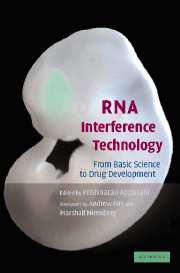Book contents
- Frontmatter
- Contents
- Foreword by Andrew Fire
- Foreword by Marshall Nirenberg
- List of Contributors
- Introduction
- Section one Basic RNAi, siRNA, microRNAs and gene-silencing mechanisms
- Section two Design, synthesis of siRNAs
- Section three Vector development and in vivo, in vitro and in ovo delivery methods
- Section four Gene silencing in model organisms
- Section five Drug target validation
- 22 Delivering siRNA in vivo for functional genomics and novel therapeutics
- 23 The role of RNA interference in drug target validation: Application to Hepatitis C
- 24 RNAi and the drug discovery process
- 25 RNA interference technology in the discovery and validation of druggable targets
- Section six Therapeutic and drug development
- Section seven High-throughput genome-wide RNAi analysis
- Index
- Plate section
- References
23 - The role of RNA interference in drug target validation: Application to Hepatitis C
Published online by Cambridge University Press: 31 July 2009
- Frontmatter
- Contents
- Foreword by Andrew Fire
- Foreword by Marshall Nirenberg
- List of Contributors
- Introduction
- Section one Basic RNAi, siRNA, microRNAs and gene-silencing mechanisms
- Section two Design, synthesis of siRNAs
- Section three Vector development and in vivo, in vitro and in ovo delivery methods
- Section four Gene silencing in model organisms
- Section five Drug target validation
- 22 Delivering siRNA in vivo for functional genomics and novel therapeutics
- 23 The role of RNA interference in drug target validation: Application to Hepatitis C
- 24 RNAi and the drug discovery process
- 25 RNA interference technology in the discovery and validation of druggable targets
- Section six Therapeutic and drug development
- Section seven High-throughput genome-wide RNAi analysis
- Index
- Plate section
- References
Summary
Introduction
The Hepatitis C Virus (HCV) is the main causative agent of non-A, non-B hepatitis in humans and a major cause of mortality and morbidity in the world. At this time there is no effective vaccination or cure for Hepatitis C, an infection affecting at least 170 million people worldwide. This slow-processing disease is transmitted through contaminated blood transfusions and needle sharing, and frequently leads to liver cirrhosis and cancer (Cohen, 1999).
The genetic pattern associated with HCV consists of a positive-sense-strand RNA genome of ∼9600 nucleotides (nts) that contains a single large open-reading frame. The structure and organization of the HCV genome is similar to those of members of the pestivirus and flavivirus genera of the family Flaviviridae (Takamizawa et al., 1991). HCV is now classified as a distinct genus of this family, with at least six major genotypes that differ from each other in their nucleotide sequence by up to 35%. The 341-nts long 5′untranslated region (5′UTR) and the adjacent core protein coding sequence are highly conserved (Simmonds, 1995; Smith et al., 1995). The HCV RNA 5′UTR contains a highly structured internal ribosome entry site (IRES) that mediates initiation of translation of the viral polyprotein by a 5′ cap-independent mechanism that is unprecedented in eukaryotes [(Jackson and Kaminski, 1995; Reynolds et al., 1995) (Figure 23.1)]. The first step in translation initiation is the assembly of a 43S preinitiation complex consisting of the eukaryotic initiation factors (eIF) 3, eIF 2, GTP, the initiator tRNA and a 40S ribosomal subunit.
Information
- Type
- Chapter
- Information
- RNA Interference TechnologyFrom Basic Science to Drug Development, pp. 318 - 330Publisher: Cambridge University PressPrint publication year: 2005
References
Accessibility standard: Unknown
Why this information is here
This section outlines the accessibility features of this content - including support for screen readers, full keyboard navigation and high-contrast display options. This may not be relevant for you.Accessibility Information
- 1
- Cited by
